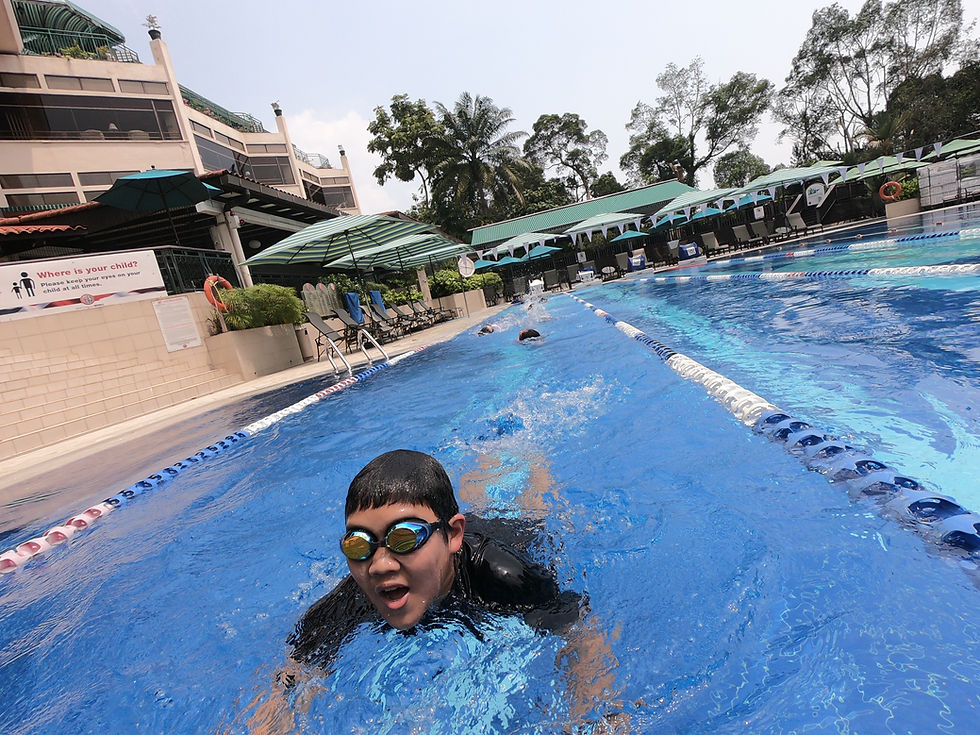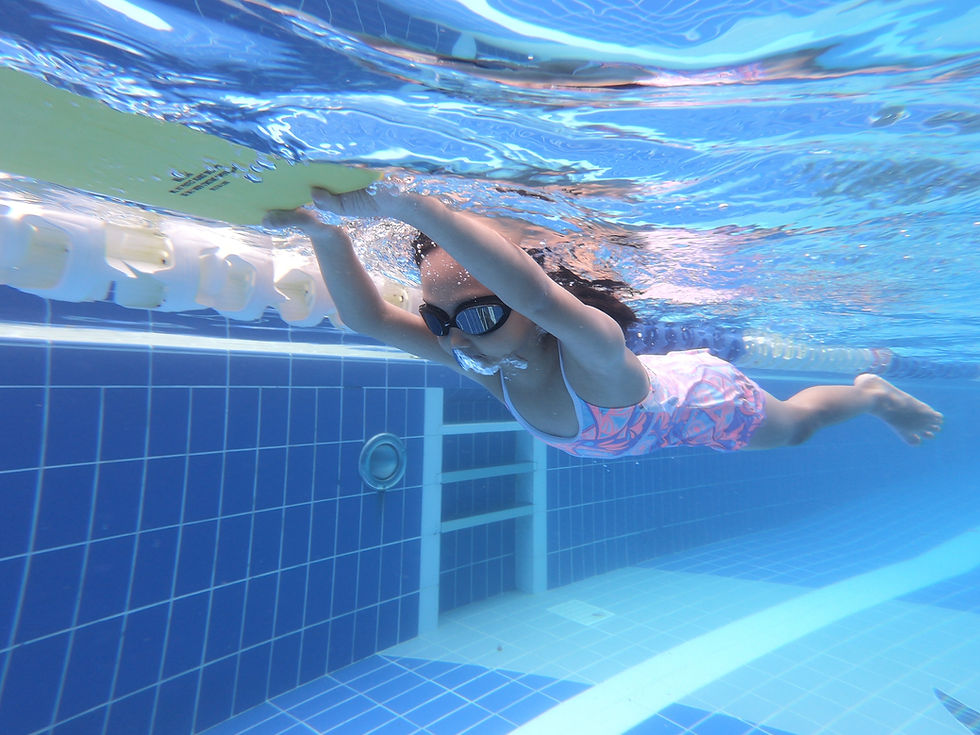Butterfly Breathing Efficiency Drills for Distance Swimmers
- SG Sink Or Swim

- Sep 26, 2025
- 5 min read

Mastering the Art of the Low, Quick, and Rhythmic Breath to Conserve Energy and Sustain Speed
For distance butterfly swimmers — those brave souls tackling 100m, 200m, or even the grueling 400m fly — breathing isn’t just about getting air. It’s about minimizing disruption, preserving body line, and maintaining rhythm over dozens of grueling cycles.
Unlike sprinters who may breathe every stroke, distance flyers must master breathing efficiency: taking just enough air, at just the right moment, with just enough head movement to stay oxygenated — without sinking, slowing, or sabotaging their stroke.
In this guide, we’ll break down the science of efficient butterfly breathing and deliver 5 targeted drills to help distance swimmers breathe smarter, not harder — so they can fly farther with less fatigue.
🎯 Why Breathing Efficiency Is Critical in Distance Butterfly
Butterfly is the most physically demanding stroke. Add inefficient breathing, and you compound the problem:
❌ Lifting the head too high → Hips drop → massive drag
❌ Holding the breath → CO₂ buildup → early fatigue
❌ Breathing too often → Disrupts rhythm, wastes energy
❌ Breathing too late → Panic, rushed recovery, stroke breakdown
“In distance fly, your breath should be a whisper — not a gasp.”— Coach Dave Salo, USC Trojan Swim
The goal? Low, quick, forward, and rhythmic — a breath that supports propulsion, not sabotages it.
🦋 The Anatomy of an Efficient Butterfly Breath
✅ The 4-Phase Breathing Sequence:
Lift — As hands press back during the pull, chest rises naturally
Inhale — Quick sip of air through the mouth (0.3–0.5 seconds)
Submerge — Head returns to neutral before arms recover
Exhale — Steady, controlled stream of bubbles underwater
💡 Key Insight: The breath is powered by the pull — not neck muscles. Let the water lift you.
🛠️ 5 Breathing Efficiency Drills for Distance Butterfly
1. “Breathe Every 3rd Stroke” Drill
Purpose: Build breath control, reduce oxygen dependence, and simulate race pacing.
How to do it:
Swim butterfly, breathing only every 3rd arm cycle
Focus on:
Keeping head low on non-breathing strokes
Exhaling steadily underwater
Using the pull’s lift to assist the breath
Sets: 4–6 x 50m, 30s rest
💡 Progression: Breathe every 4th or 5th stroke as fitness improves
🎯 Cue: “Two down, one up. Stay long, stay low.”
2. Snorkel Butterfly with Controlled Exhale
Purpose: Eliminate breath timing stress and teach consistent underwater exhalation.
How to do it:
Use a front-mounted snorkel
Swim butterfly at moderate pace
Focus on steady, rhythmic exhalation — no breath-holding
Feel how a relaxed exhale keeps the body calm and buoyant
Sets: 4 x 25m, 20s rest
⚠️ Remove snorkel after drill to apply the feeling to real breathing
🎯 Cue: “Bubbles = calm. Holding = panic.”
3. “Low-Head” Butterfly with Fingertip Drag
Purpose: Reinforce minimal head lift and relaxed recovery.
How to do it:
During recovery, drag fingertips lightly across the surface
Breathe with eyes looking 2–3 meters ahead — not at ceiling
Imagine “sneaking a breath” through a keyhole
Sets: 4–6 x 25m, 30s rest
💡 Place a tennis ball under chin (in shallow water) to prevent lifting
🎯 Cue: “Breathe forward, not up. Slide your head, don’t lift it.”
4. Underwater Exhale Count Drill
Purpose: Build CO₂ tolerance and controlled breathing rhythm.
How to do it:
Push off wall in streamline
Perform 3 butterfly strokes underwater (legal in training)
On 3rd stroke, surface and take one quick breath
Immediately submerge and repeat
Count how many bubbles you exhale between breaths (aim for 10–15 steady bubbles)
Sets: 4 x 25m, 45s rest
🎯 Cue: “Long exhale = calm body. Short exhale = tension.”
5. Tempo Trainer Breathing Ladder
Purpose: Lock in breathing rhythm at race-specific tempos.
How to do it:
Sets: 4 x 50m, 45s rest
🎯 Cue: “Breathe to the beep — don’t break the rhythm.”
📊 Breathing Strategies by Race Distance
100m | Every 1–2 strokes | Max oxygen, minimal head lift |
200m | Every 2–3 strokes | Balance oxygen and rhythm |
400m | Every 3–4+ strokes | Conserve energy, extend glide, stay low |
💡 Elite Example: Chad le Clos (200m fly): Breathes every 3 strokes Kristóf Milák (100/200m): Low head, quick sip, immediate submersion
🧠 Mental & Physiological Tips
✅ Exhale 80% underwater — never hold your breath
✅ Inhale through mouth only — faster than nose
✅ Keep chin tucked — imagine a tennis ball under your chin
✅ Breathe with your chest, not your neck — let the pull create lift
✅ Practice breath-holding tolerance — safely, in controlled sets (e.g., 10s underwater bobs)
“Your lungs are your engine. Your breath is your fuel. Don’t waste a drop.”
🏊 Sample Breathing Efficiency Workout (60 Minutes)
Warm-Up:
400m easy choice + 4 x 50m drills (catch-up, side kick)
Technique Set:
4 x 25m Snorkel Fly (focus: steady exhale) — 20s rest
4 x 25m Fingertip Drag Fly (focus: low head) — 30s rest
4 x 25m Breathe Every 3rd — 30s rest
Main Set:
5 x 100m Butterfly @ threshold pace
Odd reps: Breathe every 2 strokes
Even reps: Breathe every 3 strokes
Rest: 45s
Focus: “Low head, quick sip, steady bubbles”
Race Simulation:
1 x 200m Fly @ goal pace — use race breathing pattern
Film or get coach feedback on head position
Cool-Down:
200m easy backstroke + 5 min stretching (neck, chest, shoulders)
💬 Coaching Cues That Stick
🦋 “Breathe like a spy — low, quick, forward.”
💧 “Your bubbles are your metronome — steady and calm.”
🧱 “Your head is a brick — slide it forward, don’t lift it.”
⏱️ “Inhale fast. Exhale slow. Glide long.”
🌬️ “If you’re gasping, you waited too long.”
Final Thoughts
Distance butterfly isn’t won by the strongest pull or the fastest kick — it’s won by the swimmer who breathes with discipline. Who trusts their exhale. Who keeps their head low when their lungs scream for air.
Master these drills, and you’ll transform your breath from a liability into a rhythm — a quiet, efficient, powerful part of your stroke that carries you farther, faster, and with more control.
So next time you push off for a 200 fly, don’t just pull and kick.
Breathe low. Exhale long. Glide smart. Fly far.
Inhale calm. Exhale chaos. Repeat with rhythm.
Because in distance butterfly, oxygen isn’t scarce — it’s strategic. 🦋💨💙





Comments